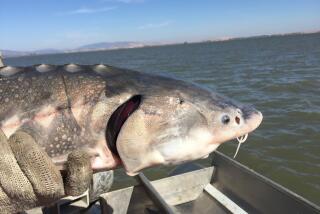COLUMN ONE : A Caviar Crisis in the Caspian : Poachers, smugglers and cash-hungry former Soviet republics are devastating the supply of precious roe. The ancient sturgeon may be fished to extinction, a victim of post-Communist lawlessness.
- Share via
BAKU, Azerbaijan — The caviar poachers gathered on the beach before the fierce sun dawned over the Caspian Sea. They belted down a morning vodka, claiming it prevented seasickness. Then they launched their wooden boats into the pale waters, knowing full well that the precious, prehistoric sturgeon they would hunt this day is a threatened species.
“There are fewer fish than before, very few now,” said Mayil, a gaunt, gold-toothed Azerbaijani fisherman who has been pilfering the once-protected sturgeon from Caspian waters for 20 of his 32 years.
“We will tell our children that we caught fish in this sea, and they will laugh at us,” he said. “They will think we are fooling them.”
He lounged across the bow of his boat, smoking acrid cigarettes and letting the breeze cool his toes, utterly unafraid of patrols that police these waters. He explained the habits of the fish whose creamy black eggs were once the feast of czars and are still the Caspian’s biggest cash crop. Other small boats came into sight as the shore faded into the hazy horizon.
Suddenly the sea was clogged with nets. The fishermen cut their motors and began to haul. The green nets shimmered as they were dragged up toward the sun. Inside was a single sevruga sturgeon, its long, strange snout tangled in the net. Though indisputably ugly, it could easily contain $500 worth of caviar.
But it was dead, and had been for some time. This is not uncommon, said Mayil, who cut it loose and flipped it back into the water. He did not snag another sturgeon this day--and, to the grief of gourmets and fishermen alike, the prospects for an abundant catch in the future look even grimmer.
Ninety percent of the world’s black caviar comes from three species of sturgeon that live in the Caspian Sea: the sleek sevruga, the white osetra and the giant beluga, the most valuable and rarest of all. The beloved beluga swam the seas in the time of the dinosaurs. Now, it may become the first species to die out as a direct result of the economic and environmental chaos created by the collapse of the Soviet Union.
The majestic fish takes up to 18 years to reach maturity, can live a century and has been known to grow to 1.5 tons. Its caviar is weighed like gold, by the ounce.
Before the Volga River was dammed on its way to the Caspian, sturgeons were known to swim more than 1,000 miles from the southern reaches of the sea to spawning grounds north of Moscow. The behemoths were sometimes shot by sailors with cannons. Even 15 years ago, the fish were so thick in the Caspian that strong northern winds washed them up on shore, and 900-pound beluga were still caught in the Volga.
Today, the average beluga weighs a puny 77 pounds, and some show symptoms of disease, ichthyologists said. More than 30 years of industrial pollution, uncontrolled use of herbicides and pesticides and clumsy oil extraction have degraded the sturgeon habitat. Dams in the three major rivers that flow into the Caspian bar them from most spawning grounds.
Scientists, however, said the main cause of the disastrous decline in the sturgeon population is massive overfishing, which began even before the breakup of the Soviet Union but has accelerated wildly in the lawless two years since.
Sturgeons are now seen as hard currency with fins. So many fish have been plucked from the Caspian that the number of sturgeons returning to spawn in the Volga has dropped threefold since 1991, said Raisa P. Khodoreskaya, a senior scientist at the Caspian Scientific Research Institute for Fisheries in Astrakhan, Russia.
The Russians call poachers brakanieri , from buccaneer, or fish pirate. With the demise of the fearsome Soviet police, they have grown brazen.
“Before we went out only at night and came back in while it was still dark,” said Ramis, 50, a poacher who works from a beach about an hour’s drive north of Baku. “Since (Soviet President Mikhail S.) Gorbachev, we fish during the day.”
In theory, Russia, Iran and Azerbaijan all have official state enterprises with a legal monopoly on fishing, packaging and exporting their caviar. In practice, however, anyone with a net can snatch a sturgeon, salt the caviar and package it in glass jars or tin cans filched from state factories. Some poachers even counterfeit state packing tins.
The quality of the “unofficial” caviar is uncertain, and some contraband has even caused food poisoning, officials said. Nevertheless, plenty of fine fish eggs have been whisked out for sale in the West by Russian caviar “mafias” that often smuggle their wares through ever more porous borders.
“In the late 1970s, early ‘80s, you had Iranians calling you saying they’ve got five suitcases of caviar (for sale), and now you’ve got Russian guys calling you saying they have five suitcases,” said Gerald M. Stein, president of Caviar & Caviar Ltd., an importer of Azerbaijani and Russian caviar in Rockville, Md. Stein’s answer is still “ nyet. “
In fact, so much caviar is pouring out of the Caspian basin that prices have dropped. Caviar that could fetch up to $900 or $1,000 a pound in fancy New York shops a few years ago is selling for $400 to $600, Stein said. Still, with a pound of fresh caviar selling for $9 in Baku--a fortune for locals--profits are irresistible.
Poachers and smugglers, however, are not the only culprits in overfishing. The new nations born from the shards of the Soviet Union are also competing for a shrinking pool of sturgeon.
Caspian caviar was once the jealously guarded bounty of just two countries--the Soviet Union and Iran. Now, five nations (Russia, Azerbaijan, Turkmenistan, Kazakhstan and Iran) and two autonomous Russian republics (Dagestan and Kalmykia) see caviar as a quick hard-currency crop.
“Each of these newly independent states has its own economic problems, and each seems to have decided, ‘Any fish that swims by my shores is mine,’ ” said Vladimir P. Ivanov, director of the nearly 100-year-old research center in Astrakhan. “Manufacturing is difficult, and here a fish swims by that’s all ready-made. All you have to do is catch it and sell it--and the more, the better.”
Negotiations aimed at establishing quotas for the five Caspian nations have so far failed, but there have been talks this month in Tehran. Ivanov and other scientists say international catch limits--strictly enforced--are the sturgeon’s only hope. “Otherwise, we will have a catastrophe, and within several years we will simply lose all the sturgeon in the Caspian Sea,” Ivanov said.
The three Caspian species are not the only endangered sturgeon. According to Vladimir I. Lukyanenko, one of the former Soviet Union’s leading ichthyologists, 19 of the world’s 26 species are either rare or disappearing, including several native to North America.
To maintain a stable population, fishermen must take fewer than 60% of the sturgeons heading from the sea to spawn in the rivers where they were born, Ivanov said. But now, up to 90% of the spawning Caspian sturgeons are killed before they can reproduce. “I think this is the last act of the modern tragedy of a family that is dying out,” Lukyanenko said. “Sturgeons are an ancient fish. They are more than 120 million years old. They even look like dinosaurs. . . . We may lose a priceless gift, a unique creation of nature.”
The sturgeon is ill-prepared to tangle with modern man. The primitive giants lumber slowly along migration routes that have remained unchanged for centuries, making them an easy mark for anglers. They swim straight into nets and rarely manage to free themselves.
The sturgeon has no bones, only cartilage. Its meat is as scrumptious as its caviar. And it may produce eggs up to a year before it is ready to spawn, making it a target for much of the year. Unlike salmon, the sturgeon does not always die after spawning. Beluga can breed up to three times in their long life.
Caspian peoples have been eating black caviar since time immemorial, and Russia’s rulers have long claimed it as a birthright. In 1672, the year Peter the Great was born, his father, Czar Alexis I, decreed that 50 royal fishermen would henceforth be required to supply the court with 1,500 sturgeons each year. When the Bolsheviks came to power in 1917, they took up where the czars left off, quickly creating a state caviar monopoly.
At the turn of the century, Russia’s official sturgeon catch was 50,000 tons of fish, but this year’s yield will be less than 5,700, according to the Ichthyological Committee of the Russian Federation. Poachers may take as much as half the official catch.
But Azerbaijan, which in Soviet times was not allowed to produce more than four tons annually, intends to produce 100 tons this year, much of it for export to the United States, said Azerbaijani Minister of Fisheries Hafiz A. Gadzhiev.
A chat with Gadzhiev showed just how far apart the Russian and Azerbaijani positions are--and how caviar politics has become entangled with the new nationalism of the independent states.
Biologists have long argued that sturgeons should never be fished from the sea, only from rivers when they return to spawn. Sturgeons in the Caspian average only up to 3% caviar by body weight and immature fish are slaughtered along with adults, said Lukyanenko, who calls sea fishing “barbaric.” Those fish that return to the river are adults averaging up to 14% caviar by body weight.
By 1962, with the sturgeon stock already diminishing, ichthyologists persuaded the Soviet Union to ban sea fishing entirely. Iran, whose rivers are all dammed, continued to fish at sea. Nevertheless, the Soviet ban, combined with an aggressive sturgeon breeding program under which the Russians release 80 million sturgeon fry into the Volga each year, had finally begun to halt the population slide, scientists said.
Now, Azerbaijan and Kazakhstan have resumed sea fishing, poachers are busy and the sturgeon is scarcer than ever. “Our hearts ache for these sturgeons,” Khodoreskaya said. “As you see, we are doing everything we can to support them, and every year there are fewer and fewer. And our hearts ache for human stupidity.”
Kazakhstan has agreed in principle to halt sea fishing in return for a share of the Volga catch. But Azerbaijan argues it has the right to set its own fishing limits within its sector of the Caspian Sea, based on the 5 million fry it releases into the sea each year.
Azerbaijan’s Gadzhiev, a flamboyant man who sports tattoos on every knuckle and whose aides stroll the ministry with pistols on their hips, dismissed as “imperialism” Moscow’s claim that sea fishing is decimating the sturgeon stocks.
“When Russia was fishing so much in the sea, nobody said anything,” the minister said. “When we started doing the same thing, they immediately said it was poaching! As soon as we put our caviar out on the world market independently, they objected. Russia should not be dictating to us what to do. We have our own science.”
Gadzhiev added that Russia seems to be attempting to discredit its rival’s caviar in the eyes of Western buyers.
“All caviar of poor quality is always said to be Azerbaijani,” he said wryly. In fact, he claimed that Azerbaijani caviar is purer and tastes better than the Volga sort precisely because it is caught in the sea.
“We fish deep in the sea, where their food is very clean, and the caviar tastes very good,” Gadzhiev said. “When fish fattens up in the river, there are sewage spills and the fish has an unpleasant odor. The Volga is very, very polluted.”
Paradoxically, natural conditions for sturgeon seem to be improving just as humans seem bent on wiping them out. The collapsing Russian economy has meant a sharp decline in manufacturing, which in turn has meant less pollution flowing into the Volga, scientists said.
In another boon to fish, the water level in the Caspian Sea--which is actually a giant lake--is rising because of climatic factors. Through most of this century, Caspian waters had been receding, making the sea saltier and reducing the sturgeon’s food supply. But since 1977, the sea has risen two meters, diluting pollutants and providing a better habitat for fish.
Even if the Caspian countries can agree on fishing quotas, the prospects for sturgeon are hardly bright.
Azerbaijan and Kazakhstan are aiming to sign contracts for offshore oil drilling in the Caspian, where some say oil reserves may prove even richer than in the North Sea. Water pollution control remains primitive to nonexistent in most of the Caspian basin. And the poachers will be hard to stop.
“We don’t have any poaching now,” Gadzhiev said. “They are all professional fishermen.”
Next dawn, the “professional” fishermen welcomed visitors with chocolate bars, fruit and promises of plenty of sturgeon. In honor of their guests, they supplemented the usual morning vodka with bittersweet Azerbaijani cognac.
They were happy to explain to visitors why they continue to catch sturgeon--and how they pay a $200 bribe each month to the Azerbaijani police and the fish inspectors to be able to do so unmolested. Under the Soviet system, they took fewer sturgeons but paid only $10 a month in bribes.
The government offers to buy the caviar from the fishermen--but at less than half the market price, they explained.
“We sell it to them for 5,000 rubles (about $5) a kilogram, and then the state sells it for export at 300,000 rubles,” Mayil said. “We work hard, and they sit in their offices and earn more than us.
“The sea does not belong to the government,” he added. Communism may be dead, but so far capitalism has been even worse for sturgeon. Mayil voices the new ideology in the Caspian: “Those who can, take.”
Alexei Kuznetzov, a researcher in The Times’ Moscow bureau, contributed to this report.
Sturgeon Under Siege
The big, lumbering sturgeons migrate from the salt water of the Caspian Sea to streams during spawning season. But dams in the three major rivers that flow into the Caspian--the Volga, Terek and Kuma--bar them from most spawning grounds.
Ancestors Traced to Dinosaur Era
Early ancestors of the body-plated sturgeon appeared in the Jurassic Period. Some background:
* Sturgeon have no bones, only cartilage.
* Because they have no teeth, they must suck food into their mouths.
* Their meat, which is usually smoked, is as scrumptious as its caviar.
* Ninety percent of the world’s black caviar comes from three species of sturgeon that live in the Caspian Sea: sevruga, ocytr and beluga.
* Unlike salmon, sturgeon do not always die after spawning.
* The head, like the body, is well-protected by plates.
* North American sturgeon were once plentiful, but overfishing, dams and pollution have greatly reduced their numbers.
Sources: Times staff, World Book
More to Read
Sign up for Essential California
The most important California stories and recommendations in your inbox every morning.
You may occasionally receive promotional content from the Los Angeles Times.












